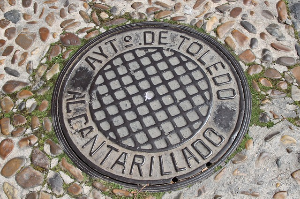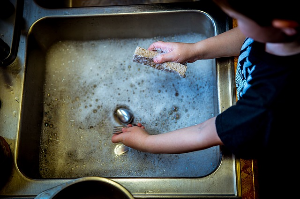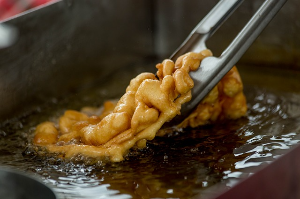
Fats, oils, and grease wastes are very common in commercial restaurant establishments. Even though they are common, disposing of them can be a little bit problematic.
Once they cool off, they transform into a viscous, semi-solid state which can present a huge problem. If your restaurant produces grill run off, you have a rotisserie or deep fryer, you need to make sure that you have a used fryer oil recycling company drop off a bin. You can dump these fatty mixtures and food into it rather than have it affect the plumbing and sewer system.
It’s important that you have a trusted oil recycling vendor and educate your staff on what needs to into the recycling receptacle. Once you have done this, you’ll also need a grease interceptor (also called grease traps) to catch the grease and food that go down your kitchen sink drain.
Grease traps do what their name suggests: they trap the grease. On top of trapping the grease, it also traps the food that go down the drain as well. Check out this post for more info on the function of a grease trap. As the grease and food accumulate in the grease trap, it stops being as efficient. The result is backups into your kitchen or parking lot, and possibly backups in the sewer system, a plumbing nightmare. Both instances are bad for your restaurant and take time to fix. So let’s talk about cleaning your grease trap.
If you don’t already have a grease trap, check out this post Installing a Grease Trap. If you do have one and you want to find out how to clean it, please read on. Alternatively, having a grease trap service provider to maintain it does wonders.
Where are Grease Traps Located?
The first step to grease trap maintenance is locating it. Commercial grease traps are normally located outside the restaurant’s building, right in the ground near the walls by your kitchen’s dishwashing area. It looks similar to a manhole or a septic tank cover.
Often it is located outside your restaurant building. If not, it is likely located in your restaurant’s basement, right below the kitchen. Grease traps are commonly installed in the basement to protect them from frost and close to the kitchen’s dishwashing station.
Grease traps can also be located right under a sink either in a box that sits on top of the kitchen floor. Or they can be hidden underneath metal flashing on the kitchen floor.
Decide Whether or Not You Should Clean it Out
After you have located the grease trap, you should consider its size when thinking about cleaning it. If it is a large outdoor grease trap under manhole covers, it is probably between 500 and 2500 gal in size. For grease traps this size, you are really better off hiring a permitted grease trap hauler to pump it out for you.
If it is a smaller indoor grease trap, you can consider pumping it out yourself, making grease trap cleaning more manageable. However, many states require you to have a septage hauler’s license to touch this environmentally sensitive material. If that is the case in your state, you are better off hiring a professional to do the job.
In North Carolina, there is a special permit for restaurant owners who want to clean out their own indoor grease trap, you can find out more about it here.
Grease Trap Cleaning Tools
Ok, so you have determined that you have a small indoor grease trap, you have gotten permitted to clean it out per your state laws or you are just going to do it without getting permitted (which we don’t recommend), what next?
When you clean out a grease trap, it’s important to use the right tools to ensure that the job is done right and not badly affect plumbing. Here are some of the basic tools needed for cleaning.
- Rubber Gloves- Grease is messy and nasty, so be sure to wear rubber gloves
- Coveralls- Want to clean wearing your best shirt or pants? Bad idea. You will definitely throw them away after grease trap cleaning. So be sure to wear protective clothing like coveralls to protect your clothes
- Crowbar, scraper, and wrench- Use the crowbar to remove the grease trap lid. Depending on the design of the grease trap, you may need to use a wrench instead of a crowbar. Use the scraper to clean the tank and baffles.
- Shop Vacuum- Use a shop vacuum to pump grease waste and liquids from the trap.
Grease Trap Parts
Commercial grease traps consist of several parts. One of these parts is the lid. The lid is often removed with a crowbar/wrench during cleaning. There are some grease trap lids that are attached with bolts.

There are also molded plastic traps that are usually snapped off during cleaning.
Grease traps also consist of baffles whose main function is to separate the flow of wastewater in the grease trap tank. Because fats, oils, and grease are lighter than water, they rise to the top of the tank. Ultimately, allowing cleaner sewage water to pass via the trap before entering the sewer system.
If it is an outdoor trap, it will have a pvc pipe fitting called an “outlet T”. Without this device, the grease trap cannot do its job, causing plumbing issues. This piece of pvc ensures that the water leaving the trap is coming from the middle of the grease trap and none of the food solids on the bottom or the floating grease on the top are getting into the sewer system.
The Procedure for Grease Trap Cleaning
As a restaurant owner/manager, it’s important to clean the trap on a regular basis. Cleaning grease traps prevent solidified fats, oils, and grease from sticking to the insides of the drainage pipes, which as a result traps food particles and other debris.
Without grease trap maintenance, over time, the trapped solid residue obstructs the flow of wastewater and causes sewage to back up. Additionally, grease can also enter the public waste system or septic system attached to your restaurant, which can lead to environmental pollution and plumbing damages.
To avoid all these problems, grease trap maintenance and cleaning must be done on a regular basis for it to work effectively. In fact, they must be cleaned every 4-6 weeks. It is also mandated by certain municipalities to be cleaned on a set frequency unless you go through a process called a “variance.”
When done in the right way, having a clean grease trap will ensure proper hygiene in your restaurant and plumbing. Grease trap maintenance will also save you tons of money on fixing clogged drains.
That being said, here is the best way to clean a grease trap.
Commercial Grease Trap Cleaning Procedure

1. First things first, you need to wait for the water inside the tank to cool down. Especially a few minutes after wastewater has been emptied from the automatic dishwasher or 3-compartment sink. Doing this will allow the grease to float on top, which will make it much easier to scoop from grease traps and place in the garbage disposal.
2. Next, gently detach the lid from the grease trap. You can detach the lid with a crowbar or wrench. Be very careful when detaching the lid. There are some gaskets located right under the lid and might get damaged, which will cost you money to replace.
3. Often, grease sludge settles at the top of the tank. This makes it easy to collect it from the top.
Take a shop vac and suck out the top floating grease first so that it does not adhere to the sides and baffles as the liquid level goes down. After you are done with this step, the remaining water and food solids should be sucked out. Make sure the dishwasher and sinks are turned off so the grease trap does not keep filling up. Keep track of how full your shop vac is getting, you do not want it to overfill and spray grease trap waste all over your kitchen!
4. Next, use a scraper to scrape off grease waste from the lid, the sides of the trap, and the baffles. Remove any large solidified pieces of fats, oils and grease that are stuck in the trap and place it into the garbage disposal. For a more thorough cleaning job, use a Shop Vacuum to suck the remaining bits of grease.
5. With most of the grease removed, it’s time to give the trap a shine. Use soap, warm water, and a steel pot scrubber to clean the lids, sides, baffles, and other parts of the trap. Doing this will also eliminate bad odor from the trap. Flush the trap with clean water to remove soap and debris.
6. To test whether the grease has been completely eliminated from the trap, drain a gallon of clean water from the kitchen sink. If the water fails to flow through, there must be a blockage in the drainage pipes which is a plumbing issue. You might want to consider calling a professional plumber to fix it.
7. Reinstall the grease trap parts and dispose of the grease waste.
8. Mix the contents of the shop vac with kitty litter until it becomes solid. Pour it into a trash bag, seal the bag, and throw it in the garbage.
Grease Trap Maintenance

To ensure that your commercial grease trap functions at an optimum level, it’s important to ensure grease trap maintenance is done properly. With proper grease trap maintenance, the trap can offer you years of convenient service. Don’t wait until things get out of hand- like grease leakage in the local water system.
Is it time for a replacement? Well, you should consider replacing your trap if it stops filtering grease out of wastewater, constantly backs up, becomes extremely hard to clean or emanates bad odors in your kitchen.
A grease trap service for its cleaning should be used a minimum of every 2 months or more frequently if excess waste has accumulated or the above-mentioned issues have occurred. If unable to do the job, you can hire professional and reliable commercial plumbing services to ensure that your grease trap is in great condition all year long.
How Much Does Grease Trap Cleaning Cost?
There are many considerations when assessing Grease Trap Cleaning Costs. To avoid complications, we recommend hiring a professional grease trap cleaning company for grease trap service. Generally, the price ranges between $115 to $1,040. It’s based on the size of the grease trap.
For more information, feel free to contact our professional company. We’ll be happy to discuss our services with you.




